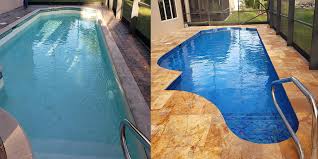A swimming pool is often the heart of a backyard, offering relaxation, entertainment, and a refreshing escape during hot summer months. However, over time, pools can deteriorate due to wear and tear, outdated designs, or inefficiencies in equipment. This is where swimming pool renovation comes in. But what exactly does a pool renovation involve, and when should you consider one? In this article, we will explore everything you need to know about swimming pool renovation, its benefits, the process, and how to ensure a successful transformation.
Swimming Pool Renovation
Swimming pool renovation sydney refers to the process of updating, repairing, or remodeling an existing pool to improve its functionality, aesthetics, and efficiency. This could range from minor cosmetic upgrades, such as resurfacing and tile replacement, to major structural changes like reshaping the pool or installing modern filtration systems.
Renovation projects can be tailored to the needs of homeowners, whether it’s to restore a pool to its original glory, enhance safety features, or incorporate the latest trends and technology.
Signs That Your Swimming Pool Needs Renovation
Before diving into a renovation project, it’s essential to identify the signs that indicate your pool may need an upgrade. Here are some common reasons why homeowners opt for a pool renovation:
1. Cracks and Structural Damage
Over time, pools can develop cracks in the surface or shell, leading to leaks and water loss. If left unattended, these issues can worsen, requiring extensive repairs.
2. Outdated Design
Trends in pool design change over the years. If your pool looks outdated and lacks modern aesthetics, a renovation can give it a fresh, contemporary look.
3. Inefficient Equipment
Older pools often have outdated filtration, heating, and lighting systems that consume more energy. Upgrading to energy-efficient pumps, heaters, and LED lighting can save money in the long run.
4. Worn-Out Pool Surface
If your pool’s plaster, tiles, or liner appear faded, chipped, or stained, resurfacing can restore its beauty and improve durability.
5. Poor Functionality
If you find your pool difficult to maintain or lacking essential features like automation, safety covers, or smart controls, a renovation can enhance convenience and usability.
6. Safety Concerns
Broken pool decks, slippery surfaces, missing handrails, or outdated safety standards can pose risks. Renovating your pool to include slip-resistant materials and compliant safety features can protect swimmers.
Aspects of Swimming Pool Renovation
Swimming pool renovation can involve a wide range of upgrades, from minor improvements to complete transformations. Here are the main aspects of a pool renovation:
1. Resurfacing the Pool
One of the most common renovation projects, resurfacing involves replacing the existing pool finish with a new material such as plaster, pebble, quartz, or fiberglass. This enhances durability, improves appearance, and prevents leaks.
2. Updating Tiles and Coping
Replacing old tiles and coping (the edging around the pool) can significantly enhance the overall aesthetics of your pool. Modern tile options include mosaic, glass, and stone, offering endless design possibilities.
3. Enhancing Pool Decking
A cracked, stained, or outdated pool deck can be replaced with new materials like stamped concrete, pavers, or composite wood to create a more visually appealing and functional space.
4. Upgrading Pool Equipment
Installing energy-efficient pool pumps, variable-speed motors, saltwater chlorinators, and advanced filtration systems can reduce operational costs while improving water quality.
5. Adding LED Lighting
Replacing old pool lights with LED fixtures can create a stunning ambiance while saving energy. Color-changing LEDs also add a fun and dynamic element to night swimming.
6. Automation and Smart Controls
Smart pool technology allows homeowners to control heating, lighting, and filtration systems remotely using mobile apps. This adds convenience and enhances pool management.
7. Water Features and Custom Additions
Adding features like waterfalls, fountains, bubblers, or infinity edges can elevate the aesthetics and experience of your pool. Custom additions such as swim-up bars, tanning ledges, and fire bowls add luxury.
8. Converting to a Saltwater System
Many homeowners are switching from traditional chlorine pools to saltwater systems for softer water, lower maintenance, and fewer harsh chemicals.
The Pool Renovation Process: Step-by-Step
The pool renovation process varies depending on the extent of work needed, but generally follows these key steps:
Step 1: Inspection and Planning
A professional pool contractor will inspect your pool, identify problem areas, and discuss renovation goals. A budget and timeline are established at this stage.
Step 2: Draining the Pool
If major renovations are required, the pool will be drained using submersible pumps. This step ensures a dry work environment for repairs and upgrades.
Step 3: Demolition and Preparation
Old surfaces, tiles, or decks may need to be removed before new materials can be installed. Cracks and structural issues are also addressed at this stage.
Step 4: Upgrades and Installation
New tiles, surfaces, plumbing, and equipment are installed according to the renovation plan. This step can take anywhere from a few days to several weeks, depending on the complexity.
Step 5: Finishing Touches
Once major work is completed, final adjustments such as sealing surfaces, testing equipment, and balancing water chemistry are done to ensure the pool is ready for use.
Step 6: Refilling and Enjoying Your Renovated Pool
The pool is refilled with water, and any necessary chemical balancing is performed. After a final inspection, it’s time to enjoy your newly renovated swimming pool!
Benefits of Swimming Pool Renovation
A well-planned renovation offers numerous benefits beyond just aesthetics. Here’s why investing in a pool renovation is worthwhile:
✅ Enhanced Aesthetics – A renovated pool enhances your backyard’s overall beauty and increases property value.
✅ Improved Functionality – Modern features and automation make pool maintenance easier and more efficient.
✅ Energy Efficiency – Upgrading to energy-efficient pumps, filters, and lighting reduces electricity costs.
✅ Safety Enhancements – Installing slip-resistant surfaces, handrails, and updated safety features ensures a safer swimming environment.
✅ Increased Longevity – Addressing structural issues and resurfacing extends the lifespan of your pool.
✅ Higher Property Value – A stylish and well-maintained pool can significantly increase the resale value of your home.
How to Choose the Right Pool Renovation Contractor
Selecting the right contractor is crucial to the success of your pool renovation. Here are some key factors to consider:
🔹 Experience and Expertise – Choose a contractor with a proven track record in pool renovations.
🔹 Customer Reviews and Testimonials – Check online reviews and ask for references to gauge customer satisfaction.
🔹 Licensing and Insurance – Ensure the contractor is licensed and insured to protect against liability.
🔹 Portfolio of Previous Work – Review past projects to assess the quality and style of their work.
🔹 Transparent Pricing – Request detailed quotes and avoid contractors with vague pricing structures.
🔹 Warranty and Support – A reputable contractor should offer warranties and post-renovation support.
Final Thoughts
Swimming pool renovation is an excellent way to breathe new life into your backyard oasis, whether you’re looking to enhance aesthetics, improve efficiency, or address structural issues. By understanding the renovation process, recognizing when an upgrade is needed, and selecting the right contractor, you can transform your pool into a stunning, functional, and enjoyable space for years to come.



